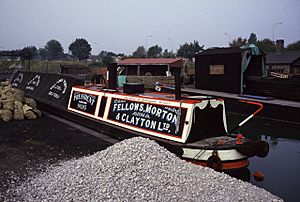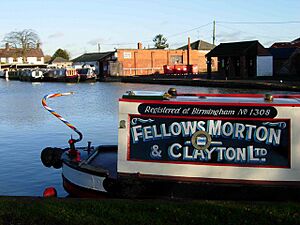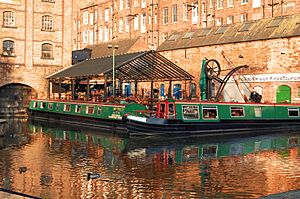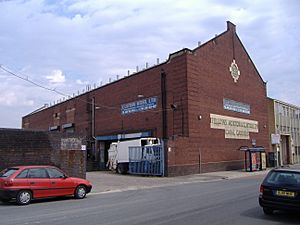Fellows Morton and Clayton facts for kids
Fellows Morton & Clayton Ltd was once the biggest and most famous company for moving goods on canals in England. It operated for many years, from 1889 until 1947. This company played a huge role in canal transport during the early 1900s.
Contents
How the Company Started
The story of this company began in 1837. A man named James Fellows, who was 32 years old, decided to start his own business. He was an agent for another canal carrier in West Bromwich. His first boat was named "Providence."
James quickly grew his business. By 1839, his boats were traveling to London very often. He moved his main operations to Toll End in Tipton in 1841. Even though his business was called a "Railway & Canal Carrier," most of his work was on the canals.
James Fellows passed away in 1854 when he was 49. His wife, Eliza, kept the business going until their son, Joshua, was old enough to join as a partner. By 1855, the company was moving 13,000 tons of iron parts between London and Birmingham every year.
In the late 1850s, a new place to build boats was set up in Tipton. By the early 1860s, the company had about 50 boats. Moving goods over long distances was the main part of their business back then.
In 1876, Frederick Morton joined the company. He brought money to help the business grow even more. The company's name changed to Fellows Morton & Co. They kept buying smaller transport companies, which added more boats to their fleet.
Forming Fellows, Morton & Clayton Ltd
In 1888-1889, William Clayton became the third partner. He had his own special boats for carrying liquids, as well as regular cargo. Sadly, William died before the companies officially joined together. His son, Thomas, took his place.
The new, bigger company, Fellows, Morton & Clayton Ltd, was officially formed on July 3, 1889. Joshua Fellows, Frederick Morton, and Thomas Clayton became the main directors. Each earned a salary of £600. Alderman Reuben Farley became the chairman. Most of the company's owners were family members of the directors.
When the company first started, they had about 11 steam-powered boats and 112 "butty boats." Butty boats are unpowered boats that are pulled by another boat. The special liquid cargo boats were moved to a new company called Thomas Clayton Limited.
The company's first financial report in 1890 showed a profit of £7,497. It wasn't an easy start, though. A big dock strike in London caused them to lose money. Also, many of their horses died from a flu outbreak.
However, the company found new ways to transport goods. They built a new boat basin and headquarters in Fazeley Street, Birmingham. They also bought out a competing company, Fanshaw and Pinson. At this time, the company was worth £84,620. Their boats and steamers were valued at £20,852, and their horses were worth £4,000.
Surviving Boats Today
Today, only 29 of these historic boats are still around. Six of them are still used! The last remaining boats are kept at the National Waterways Museum. We know that 12 boats have sunk, and two are currently being fixed up.
Steam-Powered Boats

At their new boatyard in Fazeley Street, the company built five steam-powered boats made of steel. But these boats didn't work out well. The steel hulls wore out too quickly.
In 1896, Fellows, Morton & Clayton Ltd tried building boats with iron sides and wooden bottoms (elm). This design worked much better! Three of the original steel steamers were rebuilt using this new method.
Between 1898 and 1899, they built 8 more iron-and-wood steam boats. They built another 9 between 1905 and 1911.
These steam boats were known as "fly-boats" or "express-boats." They were mainly used for long-distance trips on the main canal routes. A trip from London to Birmingham would take about 54 hours! It was a non-stop service. The crew of four would change shifts along the way. The main problem was that the large engine and boiler took up a lot of space, so the boats couldn't carry as much cargo. They would pick up fuel (coke) at certain points along their journey.
One famous steam boat, the President, is still around today. It is owned and operated by the Black Country Living Museum.
Motor Boats
In 1906, the company tried an experiment on a steamer called "Vulcan." They put a special "gas suction engine" in it. This engine meant they needed fewer crew members and used less fuel. However, the engine was still very big.
In 1911, a competing company tried a "semi-diesel engine" which worked well. Fellows, Morton & Clayton Ltd decided to try this new engine too. They built a boat called "Linda" to test a Swedish Bolinder engine. This boat had a similar shape to their steam boats but with a shorter engine room. "Linda" became the first motor boat in their fleet.
The new engine was a big success! They immediately started building nine more motor boats. Because these new engines were so good, the company converted all their steam boats into motor boats by 1927.
Fellows, Morton & Clayton Ltd mostly built their own boats. Their Uxbridge dock built wooden boats, and their Saltley dock built new boats and fixed old ones. In 1922, they asked another company, W.J. Yarwood & Sons in Northwich, to build 12 motor boats for them. The first of these arrived in May 1923. They ordered 12 more from Yarwoods in 1926, which were delivered as just the empty hulls.
Company Locations
The main office for Fellows, Morton & Clayton Ltd was in Fazeley Street, Birmingham. They also had many other depots (storage and stopping points) in different places.
|
|
|
Boat Colours
The first colours used on Fellows, Morton & Clayton Ltd boats were black and white, with a red line in between. After the company was reorganized in 1921, they changed their boat colours to red, green, and yellow.
The End of the Company
In the first half of 1948, Fellows, Morton & Clayton Ltd lost money for the first time, about £5,000. In November 1948, the company decided to close down. The British Transport Commission took over all their assets on January 1, 1949.
Images for kids
-
1909-built FMC steam narrowboat President, preserved in working order, based at the Black Country Living Museum








